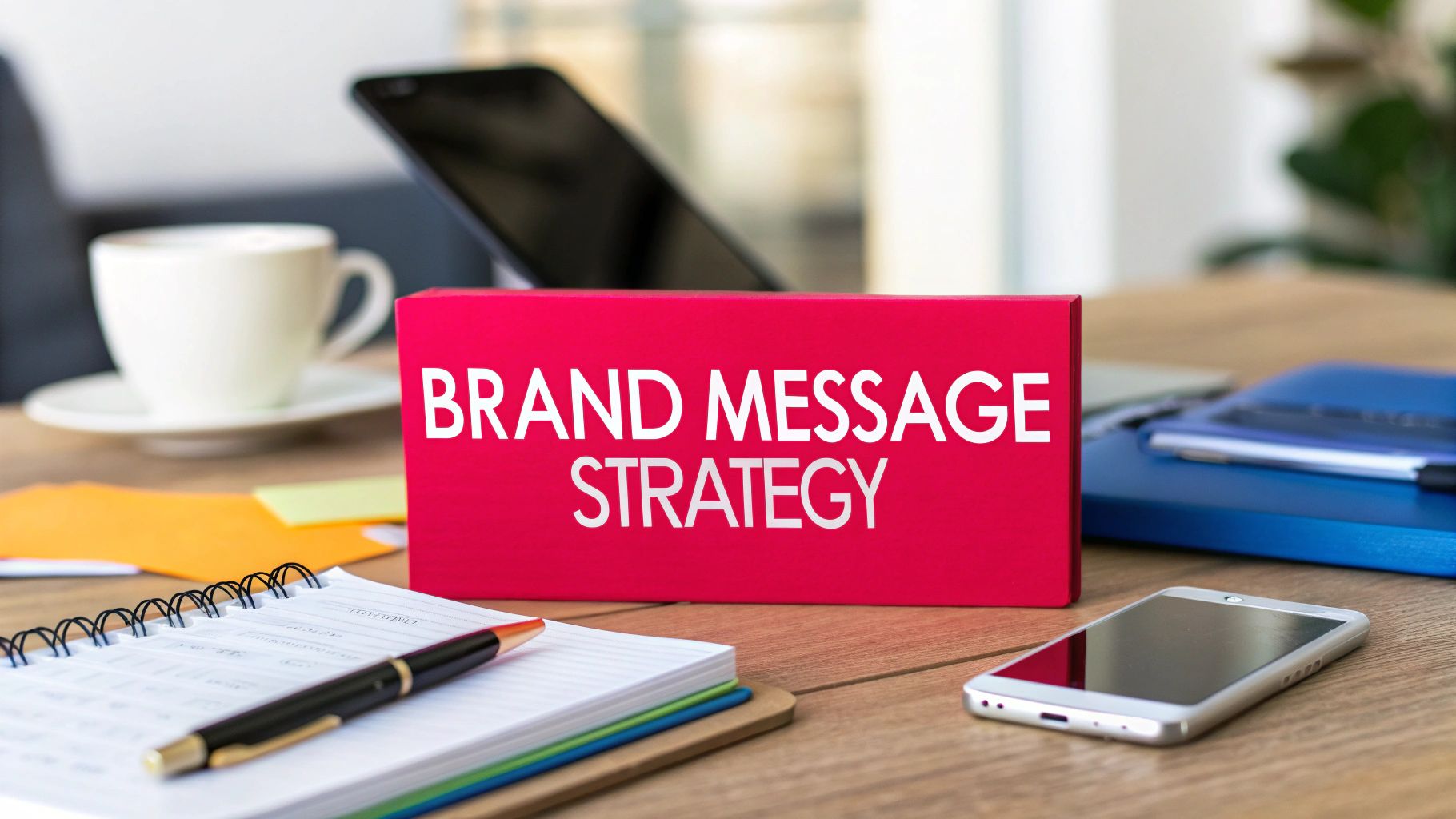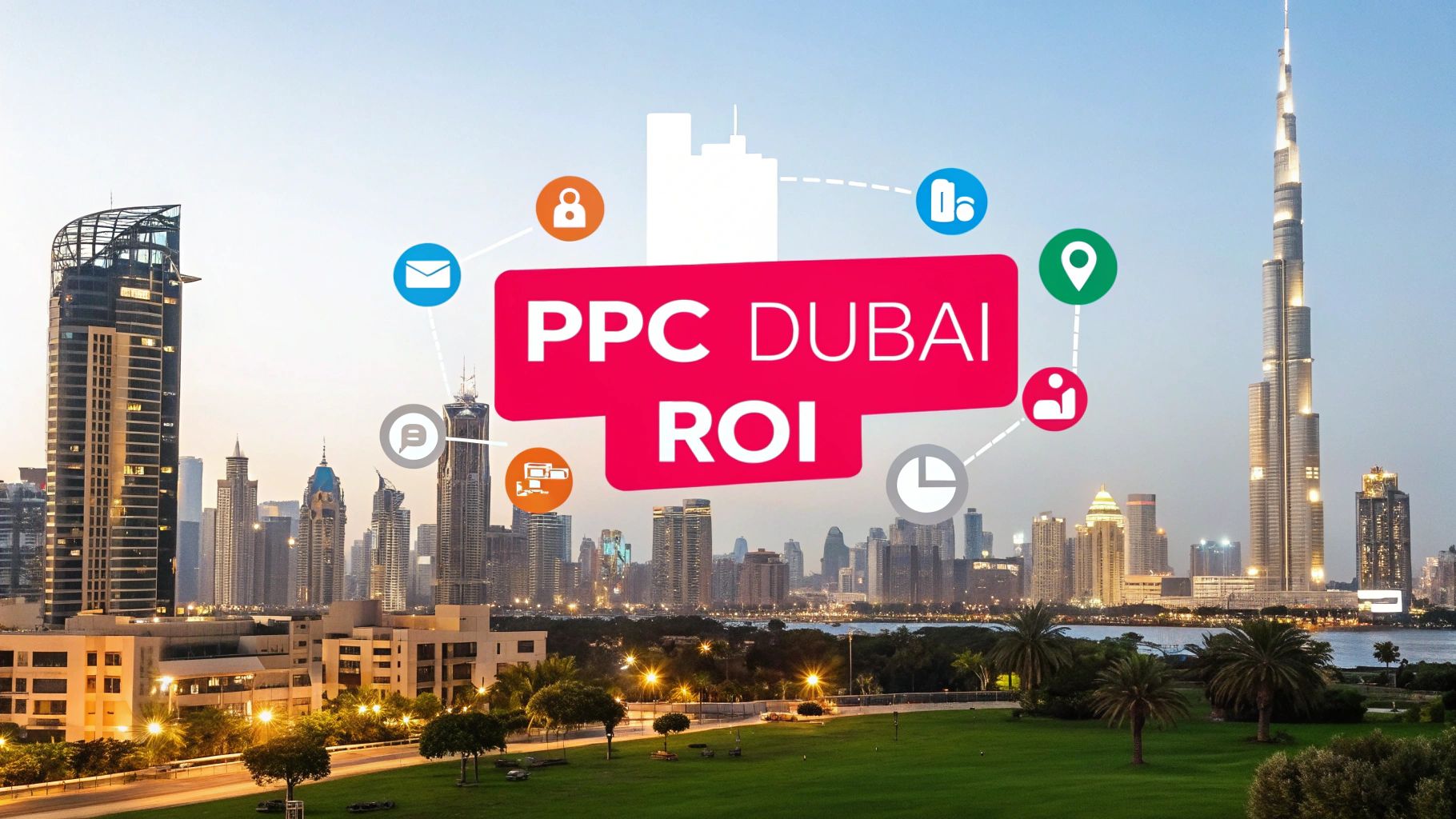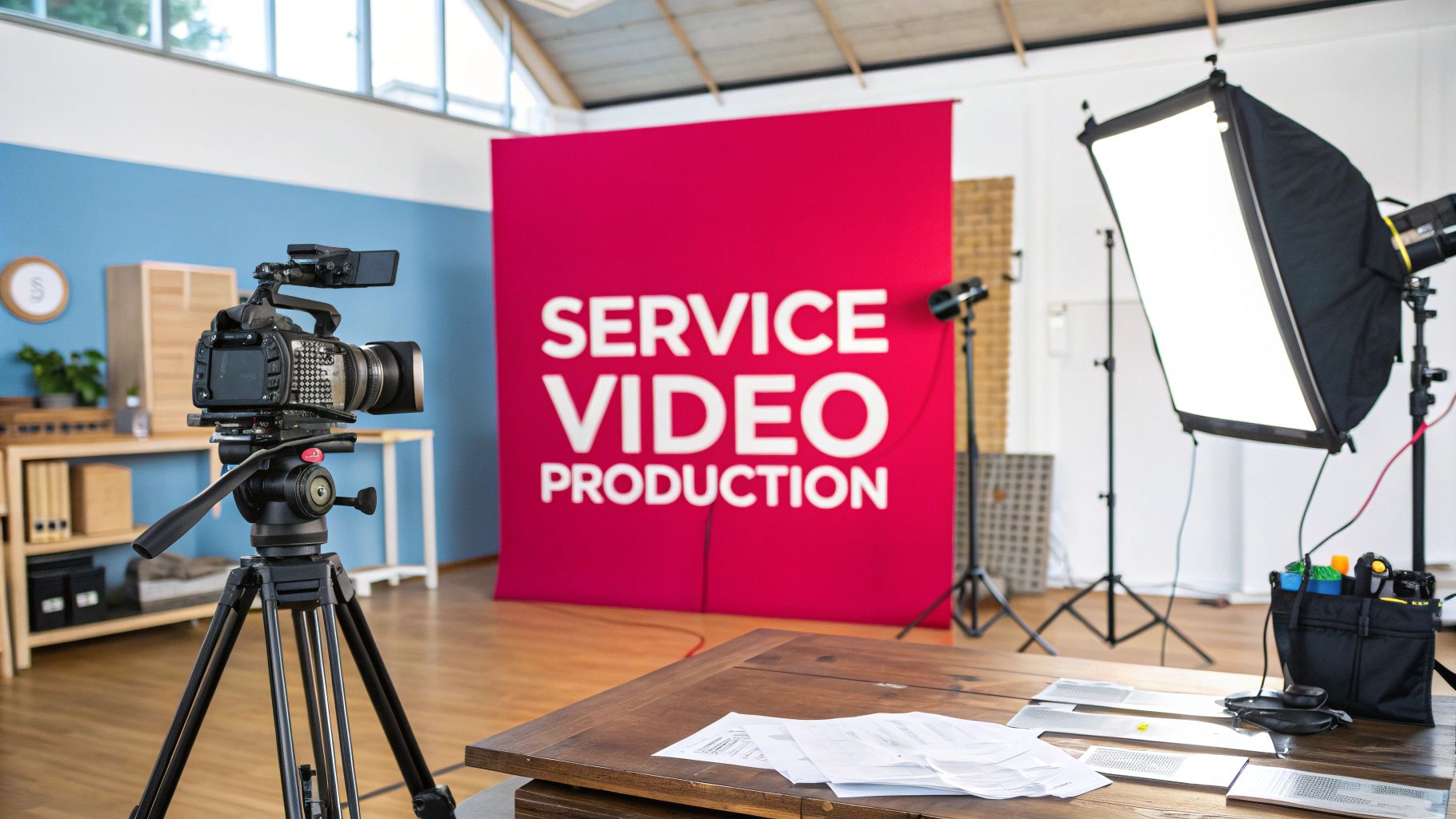Think of your brand message strategy as the DNA of your communication. It’s the blueprint that dictates what your business says, how you say it, and who you're saying it to. When done right, every piece of content—from a headline on your homepage to a quick social media update—feels consistent, authentic, and genuinely connects with your audience. This is how you build trust and stand out from the noise.
Defining Your Brand's Foundational Identity

Before you write a single word of copy, you have to answer one crucial question: who are you, really? This isn't about brainstorming clever taglines just yet. It’s about doing the foundational work—the strategic soul-searching that ensures your messaging is built on solid ground.
This means digging deeper than just corporate jargon. You need to define a mission, vision, and set of values that your team can actually get behind and live by. These aren't just for your 'About Us' page; they're the north star for every decision you make.
To get started, it helps to organize these foundational pillars. This table breaks down the core components you need to define.
Core Components of Your Brand Identity
| Component | What It Defines | Key Question to Answer |
|---|---|---|
| Mission | Your purpose; the why behind your existence. | Why do we do what we do? |
| Vision | Your future aspiration; the ultimate impact you want to make. | What does the world look like if we succeed? |
| Values | Your guiding principles; the non-negotiable beliefs that drive behavior. | How do we promise to act, internally and externally? |
| Brand Voice | Your personality; the tone and style of your communication. | If our brand were a person, how would they speak? |
| Unique Selling Prop. | Your key differentiator; what makes you the only choice. | Why should someone choose us over anyone else? |
Getting these elements down on paper is the first real step toward building a message that doesn't just sell, but resonates.
Understand Your Audience Deeply
Here's a mistake I see all the time: businesses get stuck on demographics. Age, location, income—that's all useful, but it doesn't get you to the heart of the matter. To craft messages that truly connect, you have to understand your audience as people.
What are their real-world problems? What are their aspirations? What keeps them up at night? Building out detailed user personas is a fantastic way to start this process. You're trying to move from broadcasting at them to having a real conversation with them.
This empathy is what turns your messaging from a sales pitch into a solution.
Find Your Voice in a Crowded Market
You have to know what your competitors are saying—and just as importantly, what they aren't saying. This exercise isn't about copying them; it's about spotting the gaps and finding your unique lane. A huge part of this is developing a distinct brand voice that feels true to you and cuts through the clutter.
For small and medium-sized enterprises (SMEs) here in the UAE, this is absolutely critical. SMEs contribute around 59% of the country's GDP, making it an incredibly competitive space. But here's the kicker: simply presenting a consistent brand across all your platforms can increase revenue by up to 23%. That’s a massive advantage.
Key Takeaway: Your brand’s identity is the perfect marriage of your internal values and your external perception. A strong brand message strategy makes sure those two things are always in sync.
This alignment is more than just good marketing; it’s a core part of your business's evolution. As you grow, weaving this messaging into your operations is essential, forming the backbone of any successful https://grassrootscreativeagency.com/digital-transformation-strategy/. By creating this blueprint from day one, you ensure every message you send out is authentic, consistent, and makes an impact.
Crafting Your Core Message and Value Proposition

Alright, you’ve laid the groundwork for your brand's identity. Now comes the fun part: giving it a voice. This is where we take all that foundational work and shape it into a clear, compelling message that actually connects with people. The goal is to make your brand memorable for all the right reasons.
At the very heart of this is your value proposition. This isn't just marketing jargon; it's the most critical piece of your entire messaging strategy. Why? Because it directly answers your customer's most important question: "What's in it for me?" It's your promise of the value they'll get, and it needs to be crystal clear.
Finding Your Unique Value Proposition
Let's be clear: your value proposition is not a clever tagline or a catchy slogan. It's a straightforward statement explaining what makes you the best choice for your ideal customer. To really nail this, you need to find that sweet spot where your brand's strengths overlap with your customer's deepest needs—and where your competitors fall short.
Think about it this way: if your brand is the solution, what specific problem do you solve better than anyone else?
For instance, a local delivery service in Dubai can't beat global giants on price or scale. So, what can they offer? Their value proposition might be something like, "Hyper-local, personalized delivery in under 60 minutes, from neighbors you trust." This immediately highlights their unique community angle and personal touch, something the big guys simply can't replicate.
Your Unique Value Proposition (UVP) is what sets your business apart. It's the clear, compelling reason a customer should choose you over everyone else. It’s not just about being different; it’s about being different in a way that matters to your audience.
Once you’ve defined this, you can start weaving it into every single piece of your marketing.
Connecting Through Brand Storytelling
Features and benefits are important, but they don't create loyalty. Stories do. A truly effective brand message creates an emotional bond, and that’s where your brand story becomes your most powerful tool. It’s the narrative that makes your brand human and gives people a reason to care.
What story can you tell? It could be about:
- The Founder's Journey: Why did you start this business? What personal struggle inspired you to find a solution for others?
- The Customer's Transformation: How does your product or service genuinely improve your customer’s life?
- The Mission's Impact: What bigger purpose does your brand serve? How are you making your community or the world a better place?
This narrative gives your value proposition context and makes it far more memorable.
Establishing a Consistent Tone of Voice
Finally, let's talk about how you say things. Your tone of voice is your brand's personality in written and spoken form. Are you professional and authoritative? Or are you witty and informal? Maybe you’re empathetic and supportive, or perhaps bold and challenging.
Whatever you choose, it has to be consistent everywhere—from your website's home page to your social media comments. This consistency is what builds trust and familiarity over time. Defining your tone is a crucial part of any solid brand messaging framework, as it ensures everyone on your team is speaking with a single, authentic voice that rings true to who you are.
Your Message, Tailored for the UAE Digital Scene

So you've nailed down a powerful core message. That’s a huge first step, but it’s only half the battle. Your message won’t land if it doesn't reach your audience where they live and breathe online. In the United Arab Emirates, that means diving headfirst into a hyper-connected, mobile-first world where digital is the default.
Simply putting your message out there and hoping for the best won't cut it. A successful brand message strategy hinges on adaptation. The formal, data-driven post that gets traction on LinkedIn will feel completely out of place on a visual playground like Instagram. The trick is to keep your core value proposition intact while tweaking the delivery for each channel's specific audience and format.
And the opportunity here is massive. We’re talking about a digital advertising market in the Middle East and North Africa (MENA) that hit around US$6.6 billion in 2023. This isn't surprising when you consider the audience: over 500 million mobile subscribers and 400 million internet users. A tailored digital message isn't just a nice-to-have; it's essential for any kind of meaningful growth.
Speaking the Language of Each Platform
Think of your core message as the central plot of your story. Each social media platform is just a different stage for telling it. The real skill is in adapting the script to fit the venue.
-
For Instagram & TikTok: These platforms are all about visual storytelling. Ditch the long paragraphs. Instead, translate your value proposition into eye-catching images, snappy Reels, and behind-the-scenes Stories. Show, don't just tell. A video of your product in action or a visual case study will go much further here.
-
For LinkedIn: This is your professional stage. Your message should pivot to focus on industry expertise, company achievements, and genuine thought leadership. Here’s where you adapt your brand story to underscore your credibility and the tangible value you bring to other businesses.
-
For X (formerly Twitter): Brevity is king. This platform is built for quick hits and real-time conversation. Use it for fast updates, jumping into relevant industry trends, and pointing your followers toward more detailed content on your blog or website.
Consistency across platforms doesn't mean copy-pasting. It means your brand's personality and underlying promise shine through, whether in a 280-character tweet or a detailed LinkedIn article.
Your Mobile-First Mandate
In the UAE, internet penetration is over 95%. It's not an assumption to say your audience is on their phone—it's a certainty. This fact has to be the bedrock of your entire brand message strategy.
Key Insight: A mobile-first mindset goes beyond a responsive website. It’s about creating messages that are easy to scan and absorb on a small screen. We’re talking short paragraphs, clear headlines, bold text for emphasis, and visuals designed for vertical viewing.
When you're zeroing in on a specific region like the UAE, you also have to navigate common cross-cultural communication challenges to make sure your message truly connects. This is deeper than simple translation. It requires a genuine understanding of local values and communication preferences to build real trust.
Ultimately, your message needs to feel like it was created for the region, not just broadcast to it. Get that right, and your brand can become a welcome and respected voice in the local conversation.
Using Influencers to Amplify Your Brand Message
Once you've crafted a powerful brand message, you need an equally powerful amplifier to get it heard. In the UAE, influencer marketing has become an undeniable force, but there's a real art to doing it right. It’s not about just paying for a post and calling it a day. The magic happens when you find partners who don't just have an audience, but who genuinely connect with your brand's core values and story.
The goal is to co-create content that seamlessly weaves your message into their own narrative. It should feel like a natural endorsement from a trusted source, not a soulless ad placement. Consumers here are savvy; they can spot a forced, transactional partnership from a mile away and will tune it out instantly.
Mega-Stars vs. Micro-Power
The influencer world isn't a one-size-fits-all game. A big question brands often grapple with is whether to go for a mega-influencer with millions of followers or a nano-influencer with a smaller, fiercely loyal community. Both have their place in a smart brand message strategy.
- Mega-Influencers: These are your go-to for massive reach. Think of them as a megaphone for brand awareness, perfect for broad campaigns designed to get your name in front of as many people as possible, fast.
- Nano-Influencers: This is where you find incredible credibility. Their followers hang on their every word, and a recommendation feels more like advice from a good friend—something far more persuasive when you're trying to drive actual sales.
Here’s a fascinating insight from the MENA market: 71.8% of brands are still chasing mid-tier and mega-influencers. This is happening despite there being over 13.2 million nano-influencers available in the region. Since local consumers are increasingly drawn to relatable, authentic content, tapping into these smaller creators is a huge, often-missed opportunity to build genuine connections.
Forging Authentic Partnerships
The secret to a successful collaboration is treating it like a true partnership, not just another line item on your marketing budget. This means you have to trust the influencer and give them the creative freedom to talk about your brand in a way that feels authentic to their audience.
You can't fake genuine excitement. When an influencer is truly on board with your brand, that passion shines through and becomes contagious.
The most powerful influencer campaigns happen when your brand's 'why' aligns perfectly with the influencer's own story and values. It’s this shared purpose that transforms a simple promotion into a compelling endorsement that resonates deeply with their followers.
To get the most out of your efforts, it's crucial to follow current influencer marketing best practices. This will keep your campaigns effective, professional, and on the right side of regulations. When you collaborate closely and focus on those shared values, influencers can become your brand's most passionate and believable advocates.
To see how this tactic fits within a complete digital strategy, our guide to social media marketing in UAE breaks down how all these pieces come together to build a formidable online presence.
Implementing and Measuring Your Message Strategy
So you’ve crafted a brilliant brand message strategy. That’s a fantastic start, but a plan on paper is just that—a plan. The real magic happens when you bring it to life. This is where your careful thinking meets the real world, and success hinges on two things: getting everyone in your company on the same page and knowing how to measure what's actually working.
Putting your strategy into motion is an inside job first. Every single person who touches your brand—from the sales team closing deals to the support agent answering a tough question—needs to communicate with one, unified voice. This is why practical, internal messaging guidelines are so important. Think of them less as a stuffy rulebook and more as a powerful tool to empower your team.
The aim is to arm everyone with the core message, key value points, and the right tone, making brand consistency feel like second nature, not a chore.
Creating Actionable Internal Guidelines
To get your entire team rowing in the same direction, you need an internal messaging document that's clear, concise, and genuinely useful. This isn't a 100-page manual destined to collect dust on a server. It’s a living, breathing playbook for how your brand shows up and speaks.
Here’s what your guidelines should cover:
- Your Core Message: Nail down the single sentence that sums up your brand’s central promise.
- Key Value Propositions: List the top 3-4 benefits that make you the clear choice for your target audience.
- Boilerplate Copy: Have pre-approved paragraphs ready to go. You'll need different versions for press releases, social media bios, and "About Us" pages.
- Tone of Voice Examples: Show, don't just tell. Provide clear "do this, not that" examples that bring your brand's personality to life.
A document like this stops your message from getting diluted over time. It ensures that whether a customer is reading a blog post or talking to a support agent, the experience feels consistently and authentically you.
A brand message strategy lives or dies by its implementation. When every team member is empowered to be a brand advocate, consistency becomes your greatest strength, building trust with every single interaction.
Tracking What Truly Matters
Once your message is out there, how do you know if it's hitting the mark? It's all too easy to get distracted by vanity metrics like likes, shares, and follows. An effective measurement plan digs deeper to track the real-world impact of your messaging. You need to zero in on Key Performance Indicators (KPIs) that tell you how well your message is being received and if it’s actually influencing behavior.
This visual breakdown highlights a few core areas that give you a much clearer picture of your message's performance.

As you can see, a high engagement rate is nice, but the real goals are making sure your audience remembers your message (recall) and that this recall leads to business results (conversion).
Moving beyond surface-level numbers requires blending both quantitative and qualitative data. This means pairing your analytics with feedback from actual human beings. You can get this valuable insight through a few different methods:
- Surveys and Polls: Don't be afraid to ask your audience directly what they remember about your brand or which specific messages stick with them.
- Social Listening: Keep an eye on online conversations using tools like Brand24 or Sprout Social. Are people talking about you in a positive light? Are they using the kinds of words you want associated with your brand?
- A/B Testing: This is your secret weapon for optimization. Test different headlines, calls-to-action, and messaging angles in your ads and on your website to get hard data on what truly connects with people.
To really get a handle on your progress, it helps to organize the metrics you're tracking.
Key Metrics for Measuring Message Effectiveness
Here’s a breakdown of the KPIs that will give you a comprehensive view of your message's performance, from initial awareness to bottom-line impact.
| Metric Category | Specific KPI | What It Measures |
|---|---|---|
| Brand Awareness | Direct Traffic, Branded Search Volume | How many people are seeking out your brand by name. A direct sign of recognition. |
| Message Recall | Aided/Unaided Brand Recall Surveys | Whether your audience can remember your brand or its message with or without a prompt. |
| Audience Engagement | Comments, Shares, Time on Page, Bounce Rate | How deeply your audience is interacting with your content. |
| Brand Sentiment | Social Listening Mentions (Positive/Negative) | The overall feeling or attitude people have toward your brand online. |
| Conversion Impact | Lead Generation Rate, Sales, Demo Requests | The ultimate test: Is your messaging driving profitable customer action? |
Tracking these metrics gives you a powerful feedback loop, allowing you to see what's resonating and where you might need to adjust your approach.
By pairing consistent, company-wide implementation with smart, focused measurement, your brand message strategy becomes more than just words. It evolves into a powerful engine that not only builds your brand's reputation but also drives tangible, sustainable growth.
Your Brand Message Strategy Questions, Answered
Got a few questions about bringing your brand message strategy to life? Good. That means you're thinking critically about the process. Here are some answers to the most common questions I hear from business owners, designed to help you sidestep common pitfalls.
How Often Should I Revisit My Brand Message Strategy?
One of the biggest blunders is treating your messaging guide as a static document you create once and file away. The truth is, your brand message should be a living, breathing part of your business that evolves as you do.
As a general rule, I recommend a light check-in at least once a year. This is just to make sure your messaging still feels fresh and aligns with what’s happening in your market. But for a full, deep-dive overhaul? Plan on doing that every 3-5 years.
Of course, sometimes a major event will force your hand and demand an immediate review. You'll want to rethink everything if you're facing:
- A fundamental change in your business model or what you sell.
- A disruptive new competitor showing up on your turf.
- A clear shift in what your customers care about or how they behave.
The goal is to stay flexible and relevant, not locked into something that no longer fits.
What's the Single Biggest Messaging Mistake to Avoid?
If there's one thing that can torpedo all your efforts, it's inconsistency. It’s the fastest way to confuse your audience and, worse, completely break down the trust you’ve worked so hard to build.
Think about it from a customer's perspective. They see a witty, laid-back ad on social media and click through. But your website greets them with stiff, corporate jargon. Later, a sales email lands in their inbox with yet another tone. This kind of disjointed experience doesn't just feel messy; it makes your brand seem flaky and untrustworthy.
A unified message, consistently delivered across every single touchpoint, is the bedrock of a strong brand. When people know who you are and what you stand for every time they interact with you, they feel confident choosing you.
How Can a Small Business Craft a Powerful Message Without a Big Budget?
This is a great question, and the answer is simpler than you think. A powerful message has almost nothing to do with your budget and everything to do with clarity and genuine connection. You don't need a Super Bowl ad slot; you need to be real and focused.
First, get laser-focused on your ideal customer. Don't just guess—talk to them. Simple email surveys, jumping on a few customer calls, or even just reading online reviews can give you incredible insight. What problems are they really trying to solve?
Next, dig deep to find what truly makes you different. It’s rarely about having the lowest price. Maybe it’s your origin story, a unique way you source your materials, or your fanatical dedication to making customers happy. Your most powerful asset is often something your competitors can't just buy.
Build a simple, honest message around that one special thing and stick to it everywhere. Authenticity always resonates more than a big, empty ad spend.
Ready to build a Grassroots Creative Agency that truly connects with your audience in the UAE? We specialize in creating data-supported, content-driven strategies that make your message unforgettable. Let's build your brand's voice together.








